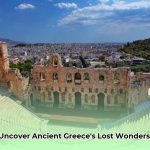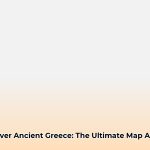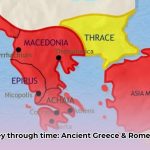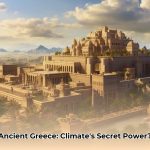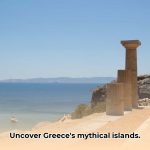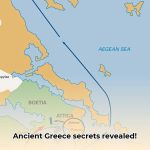Envision a tapestry of islands, each a jewel shimmering with echoes of millennia past. This is the realm of ancient Greece, where sun-drenched shores whisper tales of gods and heroes. From the vibrant frescoes of Minoan Crete to the sacred ruins of Delos, these islands are more than picturesque destinations—they are living museums, inviting us to step back in time and explore the roots of Western civilization. For a visual guide, see this Ancient Greece map. Prepare for an odyssey where myth and history intertwine, revealing the breathtaking beauty and enduring legacy of Greece’s isles.
Embarking on a Historical Voyage: The Aegean’s Timeless Charms
Imagine setting foot on a sun-kissed Greek island, the cerulean sea stretching before you, the air alive with the scent of thyme and salt. Here, history isn’t confined to textbooks; it permeates the very stones beneath your feet. The Greek islands, a constellation scattered across the Aegean and Ionian Seas, offer an unparalleled journey through time, from the Bronze Age to the Roman Empire and beyond. While pinpointing an exact number remains elusive—estimates range from 1,200 to over 6,000—the approximately 227 inhabited islands alone hold a treasure trove of historical and archaeological wonders, inviting exploration and discovery.
From Minoan Palaces to Roman Rule: A Tapestry of Civilizations
The story of the Greek islands begins long before the rise of Athens and Sparta. On Crete, the Minoans, a sophisticated Bronze Age civilization, flourished from around 2700 to 1450 BCE. Their advanced society is evidenced by the elaborate Palace of Knossos, a labyrinthine complex adorned with vibrant frescoes and intricate architectural details. The Minoans were master seafarers, traders, and artists, leaving behind a legacy of innovation and cultural achievement.
Following the Minoans, the Mycenaeans, a warrior culture from mainland Greece, rose to prominence, leaving their mark on the islands with imposing citadels and fortified settlements. As Classical Greece emerged, the islands became vital centers of trade, religious pilgrimage, and strategic importance. Delos transformed into a sacred sanctuary dedicated to Apollo and Artemis, drawing pilgrims and merchants from across the Aegean. Rhodes, strategically located at the crossroads of Europe, Asia, and Africa, became a major maritime power, its wealth and influence symbolized by the Colossus, a towering bronze statue that stood as one of the Seven Wonders of the Ancient World. Later, the Roman Empire extended its reach, incorporating the islands into its vast network of trade and governance. Each civilization contributed to the islands’ unique cultural identity, leaving behind a rich mosaic of archaeological sites, myths, and traditions.
Island Chronicles: Unveiling Legendary Destinations
Let’s delve into the unique stories of some of the most captivating islands:
- Crete: Beyond Knossos, Crete boasts a wealth of Minoan treasures, including the palaces of Phaistos and Zakros, each revealing different aspects of this advanced civilization. The island’s strategic location in the Eastern Mediterranean made it a crossroads of cultures and a pivotal player in ancient history.
- Delos: As the mythological birthplace of Apollo and Artemis, Delos was revered as a sacred sanctuary for centuries. Today, this uninhabited island is an open-air museum, its ruins offering a glimpse into its past as a religious and commercial hub.
- Santorini: The dramatic volcanic landscape of Santorini is a testament to the power of nature. The Minoan settlement of Akrotiri, preserved by volcanic ash, provides an unparalleled window into daily life during the Bronze Age.
- Rhodes: The medieval city of Rhodes, a UNESCO World Heritage Site, stands as a reminder of the island’s strategic importance and rich history. Explore its cobbled streets, admire its fortifications, and imagine the knights who once walked its walls.
Each island holds a unique narrative, shaped by archaeological discoveries, myths, and legends. Their mythological significance adds another layer to their allure, inviting us to connect with the ancient world on a deeper level.
Balancing Act: Tourism, Preservation, and Enduring Legacy
Tourism is a vital engine of the Greek economy, particularly for the islands. However, unchecked growth poses a threat to their fragile ecosystems, irreplaceable historical sites, and unique cultural identities. Finding a sustainable balance between economic development and environmental and cultural preservation is a critical challenge, requiring innovative solutions and collaborative efforts. Sustainable tourism practices offer a path towards generating income while protecting the islands’ natural and cultural treasures for future generations. This means prioritizing responsible travel, supporting local communities, minimizing environmental impact, and ensuring the preservation of these unique destinations.
A Sustainable Sojourn: Preserving the Echoes of the Past
Imagine embarking on a transformative journey, island-hopping across the Aegean, where each destination offers a unique blend of history, culture, and natural beauty. This isn’t just a vacation; it’s an opportunity to connect with the past while contributing to a sustainable future.
Essential Considerations:
- Planning Ahead: Secure accommodations and tours in advance, especially during peak season (June-August), to ensure availability and support businesses committed to sustainable practices.
- Budgeting Wisely: Factor in varying island costs and accommodation options, seeking out locally owned establishments that prioritize sustainability and community engagement.
- Embracing Sustainability: Minimize your environmental footprint by opting for eco-friendly transportation, reducing waste, and supporting local conservation efforts.
Crete: Immersing in Minoan Splendor
Crete, the largest of the Greek islands, invites you to explore the remnants of the Minoan civilization, a society that flourished thousands of years ago. Wander through the Palace of Knossos, imagining the vibrant life that once filled its halls. Respect the environment, support local artisans, and savor authentic Cretan cuisine at family-run tavernas.
Delos: Honoring a Sacred Legacy
Delos, steeped in mythology and history, demands careful and respectful tourism practices. Explore the ruins with a knowledgeable guide, learning about the island’s significance as a religious and commercial center. By minimizing your impact and supporting local conservation efforts, you can help preserve this fragile ecosystem for future generations.
Rhodes: Journeying Through Time
Rhodes, with its medieval city and ancient acropolis, offers a journey through time. Explore the island on foot or by bicycle, minimizing your carbon footprint and immersing yourself in its rich history and culture. Seek out locally owned businesses committed to sustainable tourism practices, ensuring that your visit benefits the community and protects the environment.
Santorini: Protecting Volcanic Grandeur
Santorini’s dramatic volcanic landscape and iconic villages captivate visitors from around the globe. By traveling during the shoulder seasons (spring and fall), you can minimize crowding and support the local economy during a slower time of year. Respect the environment, support local conservation efforts, and savor the island’s unique culinary traditions, contributing to a more sustainable and enriching travel experience.
Conscious Engagement: Shaping a Legacy of Preservation
Responsible tourism is paramount. Choose accommodations, restaurants, and tour operators committed to environmental sustainability and fair labor practices. Support local businesses, respect cultural norms, and minimize your waste. By consciously engaging with the land and culture, you become a part of a historical narrative of preservation and respect, honoring the ancient sites and the delicate environment surrounding them.
Ancient Greek Islands: A Call to Responsible Stewardship
Envision a transformative journey through time, island-hopping across the Aegean. From the Minoan palaces of Crete, where frescoes whisper tales of a sophisticated civilization, to the sun-drenched shores of Santorini, scarred by volcanic fury and steeped in myth, each island echoes with history. However, overtourism imperils Greece’s historical sites and natural beauty.
Core Principles:
- Sustainable tourism is critical for harmonizing economic prosperity with cultural and environmental preservation.
- Integrating modern technology with ancient wisdom can guide sustainable practices.
- Ensuring the longevity of Greece’s cultural heritage mandates responsible tourism.
From Minoan Palaces to Enduring Preservation
From the Minoan palaces of Crete, whispering tales of a sophisticated civilization, to the sun-drenched shores of Santorini, scarred by volcanic fury and steeped in myth, each island resonates with echoes of the past. Mycenaean warriors once traversed these lands, their bronze swords glinting under the Aegean sun. Later, the Classical Greeks introduced their groundbreaking philosophies and democratic ideals, erecting magnificent temples and thriving cities. The Roman Empire, too, indelibly marked these islands, leaving behind a rich tapestry of cultural influences. Navigating Ancient Greece’s Islands: Sustainable Tourism Practices necessitates a profound appreciation of this intricate and layered history.
Island Chronicles: Safeguarding the Past
Delos, a sacred island dedicated to Apollo, stands as a repository of archaeological marvels. Rhodes, renowned for its Colossus, boasts a captivating medieval city juxtaposed with ancient ruins. The narratives of these locales are interwoven with the very fabric of their existence. How can we ensure that future generations have the opportunity to experience this extraordinary legacy firsthand? This is the central challenge of Exploring Ancient Greece’s Islands: Sustainable Tourism Practices.
Balancing Tourism and Conservation
Tourism serves as a crucial economic lifeline for Greece, yet unrestrained expansion can jeopardize fragile ecosystems and irreplaceable historical sites. Overcrowding inflicts damage on ancient ruins, pollution diminishes environmental quality, and unsustainable practices erode cultural authenticity. What are the far-reaching, adverse impacts of unrestricted tourism that demand our immediate attention?
Sustainable Practices: Ancient Wisdom for Modern Journeys
Responsible island exploration entails selecting eco-conscious accommodations, utilizing public transportation networks, championing local enterprises, and upholding local customs. It involves minimizing our ecological impact and eschewing single-use plastics.
Drawing inspiration from the ancient Greek ideals of moderation and hospitality provides invaluable insights. We can seamlessly integrate these timeless principles into contemporary tourism. Smart technology offers additional support. Mobile applications can guide visitors toward lesser-known attractions, thereby alleviating strain on heavily trafficked areas. How can we harness modern technology to promote responsible and sustainable practices?
The Future of Island Exploration
The destiny of these islands rests on our collective shoulders. The key lies in embracing Exploring Ancient Greece’s Islands: Sustainable Tourism Practices and making informed decisions when venturing to this enchanting destination. Let us ensure that these islands continue to resonate with history and myth for countless generations to come.
Ancient Greek Islands: Bridging Preservation and Progress
Imagine stepping onto an island that is not merely a picturesque vacation spot but a living, breathing museum. This is the reality that defines many Ancient Greek Islands. From the Minoan palaces of Crete to the sun-drenched ruins of Delos, these islands serve as tangible testimonies to millennia of rich history. Each island harbors unique narratives—the strategic significance of Rhodes, the volcanic drama of Santorini—all intricately woven into a delicate heritage.
Key Imperatives:
- Greece confronts the challenge of striking a balance between safeguarding its invaluable cultural heritage and fostering sustainable economic development.
- Successful integration of archaeological discoveries into infrastructure projects, as demonstrated in Athens and Thessaloniki, serves as an exemplary model.
- Adopting a comprehensive, long-term preservation strategy that transcends short-term agendas is of paramount importance.
Crete’s Minoan Legacy: Conserving Knossos
Crete boasts the Palace of Knossos, an awe-inspiring Minoan palace complex renowned for its exquisite artistry and groundbreaking innovation. Conserving such sites requires substantial investments and the expertise of skilled conservationists. Tourism, while serving as a vital economic driver, presents a formidable challenge. Excessive visitor traffic can inflict damage on delicate artifacts and gradually erode the very essence of these historical treasures.
Santorini’s Volcanic Marvel: Preserving Akrotiri
Santorini contends with the intricate task of balancing the allure of mass tourism with the imperative of preserving its distinctive volcanic landscape and the ancient Akrotiri settlement. How can we effectively manage the influx of tourists to ensure that these sites remain both protected and vibrant for posterity? It’s a precarious equilibrium that demands careful consideration.
Economic Opportunities and Sustainability
Ancient Greek Islands possess substantial economic potential, with tourism serving as the dominant force. The optimal solution lies in directing investments toward sustainable infrastructure, promoting local enterprises, and educating both visitors and residents about the critical importance of heritage preservation.
Charting the Course: Intertwining Preservation and Progress
The imperative of preserving the Ancient Greek Islands extends beyond merely safeguarding inanimate stones; it encompasses the vital task of protecting a legacy that continues to shape our world. This necessitates collaborative partnerships among the Greek government, local communities, archaeologists, and the tourism sector. The successful integration of archaeological discoveries into infrastructure projects, as exemplified in Athens and Thessaloniki, should serve as a guiding framework for future endeavors. Can we improve the integration of ancient artifacts with modern infrastructure?
The Greek Islands beckon not merely as destinations for tourists but as sanctuaries entrusted to responsible stewards who will champion the mission of safeguarding their unique and irreplaceable legacy for the benefit of generations yet to come.
- Explore the Marathon Ancient Greece Map: A New Perspective on the Iconic Battle - August 12, 2025
- Explore Ancient Greece Drawings: Styles, Periods and Enduring Examples - August 12, 2025
- Ever Wondered About Toxic Truths? Makeup in Ancient Greece Unveiled! - August 12, 2025

